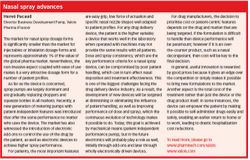Handbook of Excipients, 6th Edition: a book review
Pharmaceutical Technology Europe
At the end of August 2009, the 6th Edition of the Handbook of Excipients appeared in print (both hard copy and interactive CD ROM).
At the end of August 2009, the 6th Edition of the Handbook of Excipients appeared in print (both hard copy and interactive CD ROM). Containing 340 monographs on pharmaceutical excipients, the handbook presents a collection of essential physical and chemical data, and other data of interest. It is divided into 22 sections covering: nonproprietary names, synonyms, chemical name and chemical abstract service (CAS) registration number, empirical formula and molecular weight, structural formula, functional category, applications in pharmaceutical formulation or technology, description, pharmacopoeial specifications, typical properties, stability and storage conditions, incompatibilities, methods of manufacture, safety, handling precautions, regulatory status, related substances, comments, specific and general references. In the last section, the authors responsible for the monograph are named and the date of revision of the monograph is recorded. A suppliers' directory for the various excipients is provided in Appendix I: first sorted in view of the excipients listed in the Handbook; and second, listing the addresses and contact information for each supplier mentioned. Appendix II provides a list of the 'EN-umbers' for the various excipients and Appendix III summarises the 'EINECS-Numbers' for the excipients. The molecular weight of the excipients is compared in Appendix IV.
Fridrun Podczeck
The information collected originates from various international sources, and compendial data are extracted from the British Pharmacopoeia, European Pharmacopoeia, Japanese Pharmacopoeia and the US Pharmacopeia/National Formulary. This makes the Handbook of Excipients a standard reference book for worldwide use in the pharmaceutical and cosmetic industries, in governmental departments involved in the regulation and licensing of pharmaceutical products, as well as in academia.
Who should use it?
The Handbook of Excipients should be on the desk of anybody involved in the development or manufacture of pharmaceutical products in Europe, the US and Japan. Development of pharmaceutical dosage forms and drug delivery devices is increasingly undertaken by nonpharmacists, and even in academia, it is the Departments of Chemical and Mechanical Engineering that get more and more involved in novel pharmaceutical developments. In these research groups, however, excipients are often used that are unacceptable in pharmaceutical products and the Handbook of Excipients is unknown and usually unavailable to these scientists; a shortage that the publishers should be able to address. Manufacturers of nutraceuticals, cosmetics and health foods should also consider obtaining at least one copy for the library. Even manufacturers of machinery (particularly capsule filling and tabletting) might find this book occasionally useful. In addition to commercial use, this book provides essential information on excipients for students and lecturers of pharmacy or pharmaceutical sciences; yet for the latter clientele, to purchase the book would require special discounts and subsidized access through their science libraries.
Handbook of Pharmaceutical Excipients, 6th Edition, August 2009
Editors: R.C. Rowe, P.J. Sheskey and M.E. Quinn
Publishers: The Pharmaceutical Press, London, UK; American Pharmaceutical Association, Washington DC, USA
ISBN: 978 0 85369 792 3 (UK) 978 1 58212 135 2 (USA)



